Best ways to improve your ecommerce customer journey
Every one of us had a customer journey in some way or the other. As a customer, we see things, evaluate them and then make a purchase. Now, as a marketer, you must have seen the customer journey in digital marketing. Many prospective customers come to your website and sometimes leave without even making a purchase.
- Didn’t they find the product they were looking for?
- What prevented the buyer from making a purchase?
- Was the cost too high?
This might leave you with many questions like:
In this blog, we will give you easy ways to find answers to all of your ecommerce discovery questions. First, we’ll start by understanding an ecommerce customer journey.
What is an ecommerce customer journey?
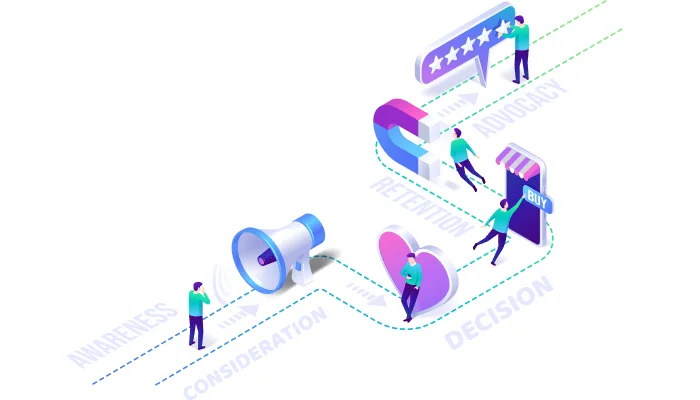
An ecommerce customer journey refers to the consumer journey stages through which a buyer goes through with an online business. The path to purchase journey is divided into many stages, from awareness to the final decision stage.
- If your website loads quickly & has a user-friendly interface, offers clear & cost-effective prices, is easier to navigate, and customer support is readily available, then most of the prospects will prefer to buy from you.
- If your site is slow to load and doesn’t respond quickly, then this might piss off the customers. Also, the higher pricing and too many pop-ups can lead them to exit your web page.
A good customer experience can have a positive impact on your prospects in many ways, for instance:
Why is an ecommerce customer journey important?
Usually, customers tend to have many opinions about online businesses based on their interactions. By breaking down these engagements and interactions into different stages, you can understand the ecommerce customer journey better.
Related: Best Customer Journey Mapping Tools
Below, we have explained the different stages of the ecommerce customer journey.
5 Stages of the customer purchase journey
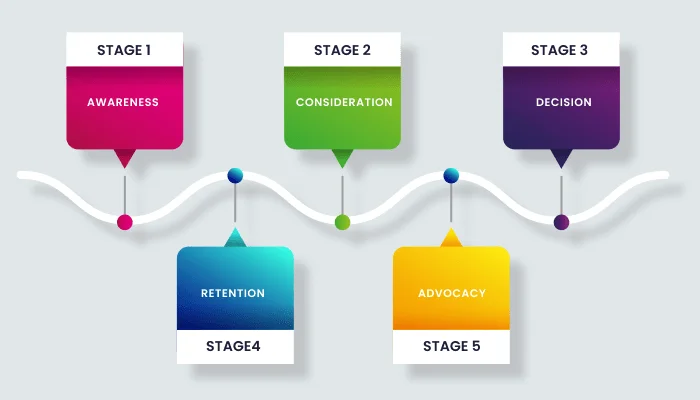
The concept of the ecommerce customer journey has been there for a long. People usually aren’t aware that they enter the online buying process once they visit a website.
- Awareness
- Consideration
- Decision
- Retention
- Advocacy
The customer journey begins from the moment a prospect engages with a website. The consumer journey has the following stages:
Now, to understand the ecommerce customer journey better, let us understand it from the consumers’ perspective:
| Discovery | Interest | Intent | Purchase | Engagement/ Loyalty |
|---|---|---|---|---|
| The customer comes across your business through different sources, such as online ads and social media. | The customer sees something interesting and starts browsing your website. | The customer likes some items and saves them in the wishlist or adds them to the cart but doesn’t make the purchase. | This phase is known as the decision-making stage. Here, the customer decides to buy the item. | If the customer likes your product or service, then they are likely to return to you. They might further |
| “I found a site that sells different types of handicraft items.” | “Let me look for a handicraft item that will look great in my living room.” | “They have so many items, but I wonder if other websites are offering the same at a better price. I’ll save these items for later.” | “I think this item is perfect and the price is also good. I’ll buy it from here.” | “I wonder if they have a new range of handicrafts for the summer season. I think I should check out their website.” |
Here, we will explain all these stages in detail so you can comprehend the customer journey better.
Stage 1: Discovery
The customer comes across your business for the first time.
This stage is also called as awareness stage, where the customer gets to know that your business exists. In this stage, you can find out where your maximum customers are coming from. You can discover the pages they are landing on and how they are navigating your website.
Gathering this information can help you know what your prospective customers need and what they look for on your website.
Stage 2: Interest
The customer finds something interesting and starts browsing your website.
This is the stage where you can focus on reducing the bounce rates of your web pages and making more people interested. You can find out how you can help customers to navigate better and list the best products which intrigue them to click.
Stage 3: Intent
The customer adds the items to the wishlist but doesn’t make the purchase. They are still considering their purchase.
At this stage, you should discover the page features that make the prospects add the products to the wishlist or cart. So when you are considering the layout of the product pages, you can design them accordingly. You can also consider adding other marketing channels in this stage to have a greater influence, such as email or intent marketing.
Stage 4: Purchase
The customer decides to make the final purchase.
This stage is also called as the decision-making or conversion stage. This is the stage where the prospect becomes a paying customer. However, once a prospect becomes your customer, that’s not the end of your task. You should see how you can improve their experience to build long-term relationships. You can also conduct post-purchase surveys or take feedback to know from your customers directly.
Stage 5: Engagement
If a customer like your product or service, they will continue to purchase and engage with your business further.
You can try and engage with your new customers by asking them to subscribe to your email list or newsletter. You can also utilize social media to interact with them and share information blogs. Marketers should make sure that they don’t lose touch with their prospects once they become customers. Moreover, retaining existing customers is easier than getting new ones in the marketing funnel.
4 simple ways to improve your ecommerce customer journey
In this section, we will tell you how you can enhance your ecommerce customer journey in easy ways.
You can start by using Google Analytics to know your website insights such as pageviews, bounce & exit rates, the average time people spend on your website, etc.
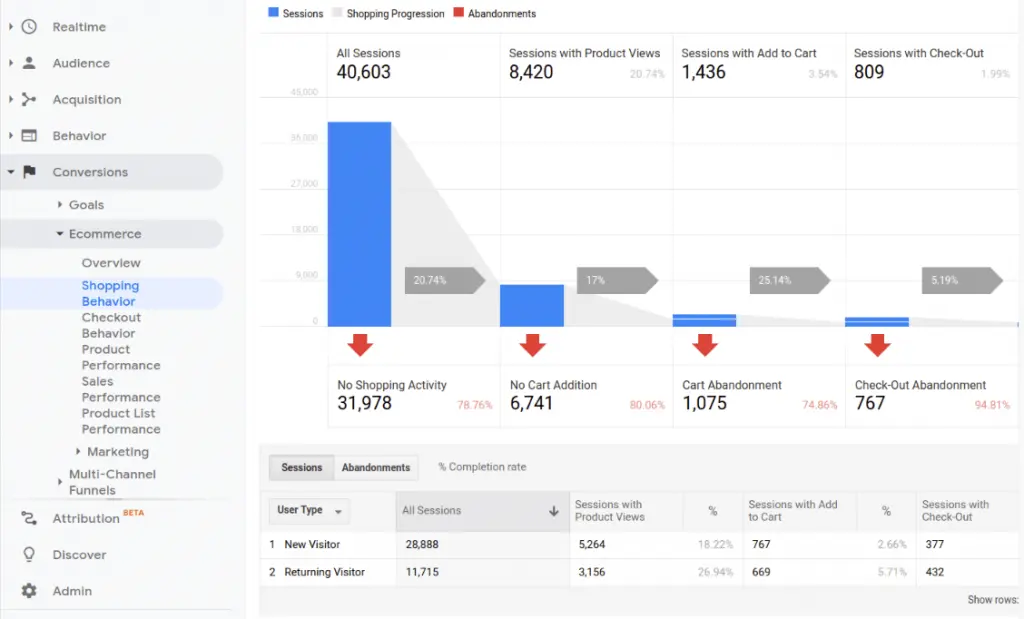
With quantitative data from GA, you can identify the UX issues and make changes accordingly. GA can help you collect a lot of data, but you can’t exactly know how your customers see your site or experience it. To understand your prospective customers better, it’s important to analyze your customers behavior. Therefore, it is essential that you gather qualitative data.
WebMaxy is an all-in-one tool that offers accurate and detailed customer behavior insights. It provides various features like session recordings, heatmaps, on-page surveys, polls, and funnel analytics. You can use WebMaxy to carry out different actions to understand your prospects better. Below, we have given 4 ways utilizing which you can improve your ecommerce customer journey.
Related: Steps to Create a Customer Journey Map
1. On-site survey to know more about the ‘discovery’ stage
By executing surveys on your high-traffic pages, such as the home page or category page, you can learn more about the initial stage of your customer journey. You can track where your customers come from and what makes them land on your website.
- From where did you hear about us?
- What exactly are you looking for today?
- What made you come here?
Consider asking different questions to your website visitors in your on-page surveys, such as:
2. Use heatmaps to know the interest areas of your visitors
You can use WebMaxy heatmaps to know how your website visitors interact and engage with the different elements of your website. Marketers can understand and identify the patterns of customers behavior. They can know which areas prospects click on and how they navigate through the site. In heatmaps, you can see the areas where the visitors have clicked the most with red and the least clicked areas with blue.
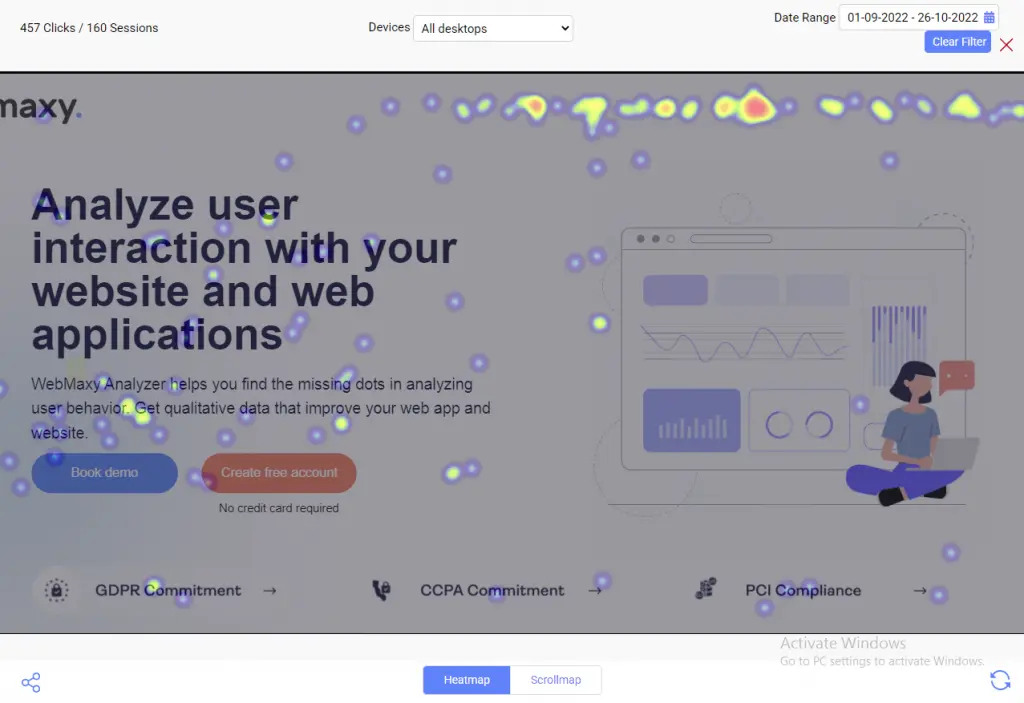
The scroll maps can help you know the areas till where people have scrolled on a page. The bright area indicates the area that has been scrolled more.
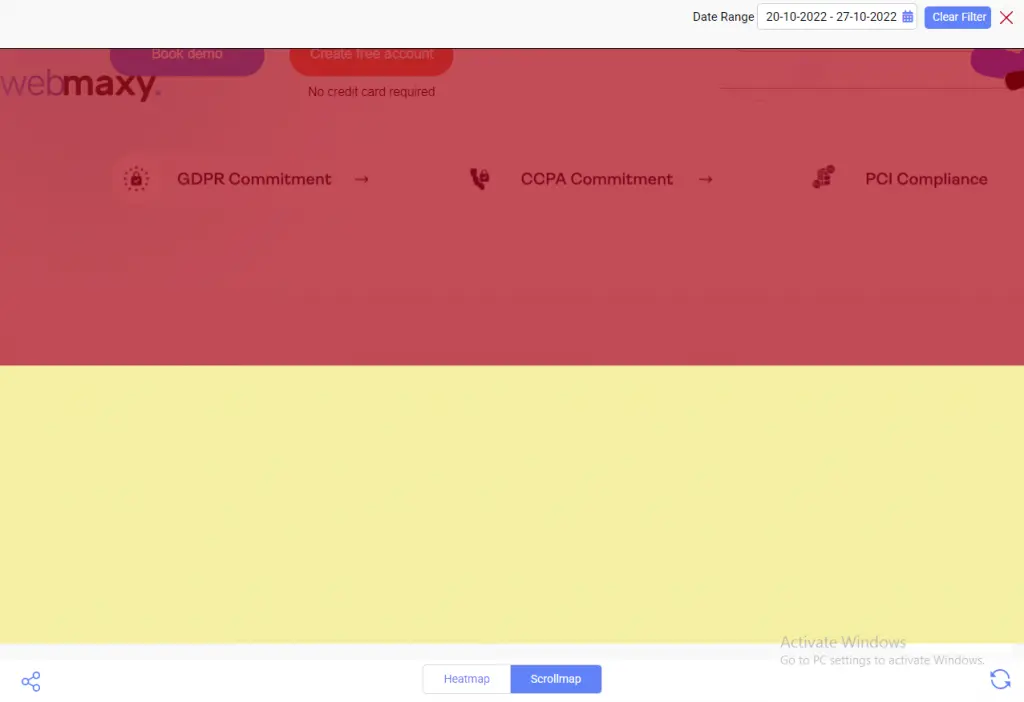
- Add new navigation options or refine the website design.
- See where the customers are clicking and add CTAs accordingly.
- Discover the areas that interest the visitors the most.
With heatmaps, you can discover a lot of insights and make changes like:
For your ecommerce website, you can use heatmaps before and after the website redesign. This will aid you in knowing if your website alterations are working for you or not. You can put heatmaps on your main pages to know the factors that lead to bounce rates and improve the conversion rate.
- If the prospects are clicking on the key elements?
- Are customers viewing the important details?
- Are website visitors facing any issues with the website?
Heatmap analysis can help you find out detailed information, such as,
3. On-page surveys to improve the intent stage
If you think that surveys are just for the discovery stage, then you are mistaken. You can use surveys at different stages of the ecommerce customer journey to identify the areas of improvement.
- What information is missing on this page?
- What do you think we need to change about our website or page?
- Why are you leaving before purchasing?
- How can we make your buying decision easier?
To enhance your intent stage, you can ask open-ended questions to your website visitors like:
WebMaxy survey feature can aid you in conducting several types of surveys on your website with ease. It offers a wide range of templates with well-researched questions that you can utilize directly.
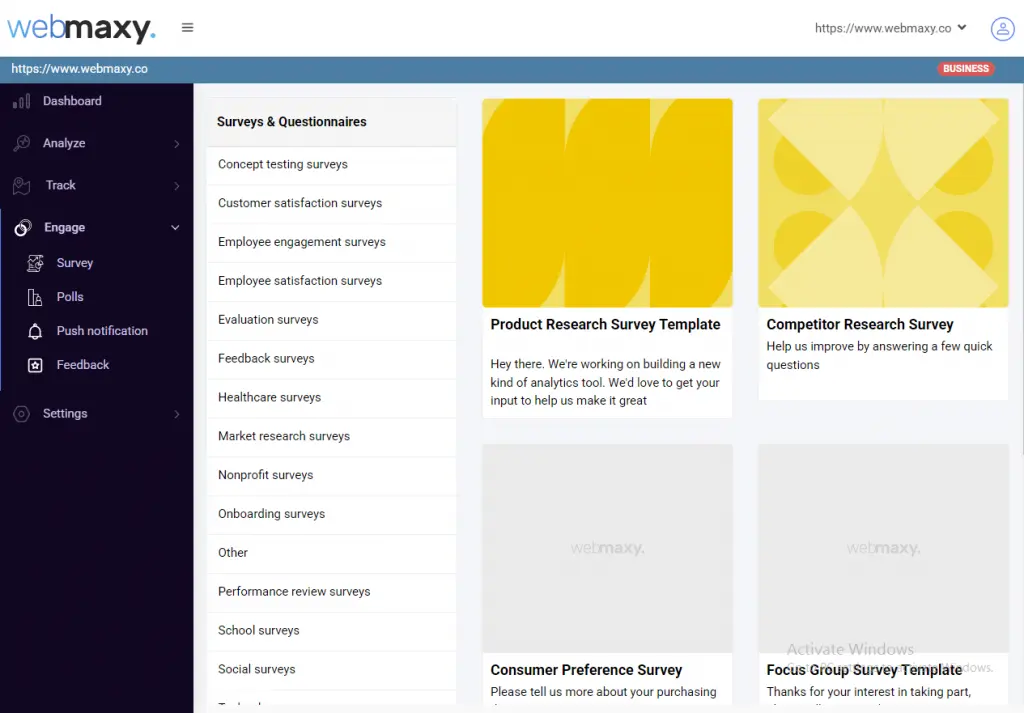
4. Post-purchase surveys to know your customers’ satisfaction level
The customer journey usually doesn’t end after a purchase. If they like a product or service, they do come back. You can send a post-purchase survey to your customers to know if they liked your products or services. This will help you to know how their ecommerce customer journey was with you.
- How would you rate your experience with us?
- Did you like our product/service?
- How would you rate our product or service on a scale of 1-10?
- Will you make a purchase from us again?
- Would you recommend our product/service to your friends or family?
You can ask several questions in the survey like:
Knowing these answers will aid you in making strategic changes and improve your ecommerce customer journey.
Wrapping Up
The primary goal of an ecommerce website is to capture the customers’ attention and lead them to purchase. Therefore, it’s essential to make your prospects’ ecommerce customer journey seamless and trouble-free. By analyzing your customers behavior and preferences, you can make value-driven decisions. WebMaxy Analyzer is a user behavior analytics tool that provides an in-depth analysis of your website visitors.
It has various features such as session recordings, heatmaps, surveys & polls, and user insights. Schedule a call with our experts to learn more about WebMaxy Analyzer, or email us at info@beta.webmaxy.co.
Get started with WebMaxy today!
Connect with us now to know more about WebMaxy Analyzer to improve eCommerce customer journey and boost your revenue.
ecommerce customer journey FAQ’s
The ecommerce customer journey can be defined as the stages through which a customer goes through with an online business, from awareness to when they finally make a purchase.
There are many stages in the ecommerce customer journey such as awareness, consideration, decision, retention, and advocacy.
Providing a good ecommerce customer experience can help you to increase your customer retention and loyalty rate. You can improve your ecommerce customer experience in the following ways:
– Have a robust content strategy
– Create an omnichannel customer experience
– Use personalization
– Provide good customer support
– Offer a loyalty program
A customer journey refers to the phases through which a customer goes through with a business. The five stages of the customer journey are given below.
1. Discovery
2. Interest
3. Intent
4. Purchase
5. Engagement
Businesses can boost their conversion rate by providing a smooth customer journey.
We have given below the four elements of the customer journey:
1. Engaging target audience
2. Converting prospects into customers
3. Retaining customers
4. Ensuring customer satisfaction
ecommerce customer journey plays an important role in the overall customer experience. You can improve your customer online journey in the following ways:
– Use social media marketing
– Optimize your website experience
– Ensure a seamless mobile experience
– Collect customer feedback



